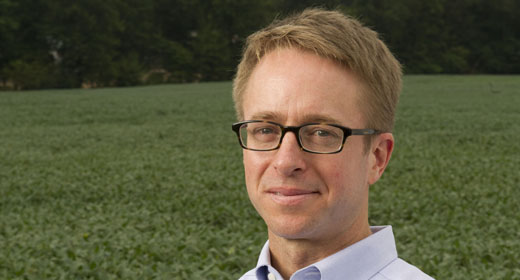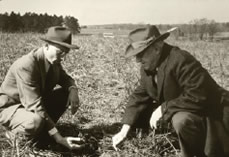
Jason Weller (MPP '99) was just out of college, with a still-crisp undergraduate degree, when the native northern-Californian took an unlikely summer job on a family ranching operation in Big Timber, Montana. He was expecting a "Brad Pitt, Legends of the Fall experience," he recalls with self-deprecating humor; instead, he wound up working harder than he'd ever worked in his life. He fixed the fences, shoveled the manure, stacked the hay, and dodged the bulls and rattlesnakes; but his most important responsibility was irrigation.
In America's dry prairies, irrigation is no small concern. In average years, the region gets less than half the rainfall seen in Washington, DC; in drought years, which hit unpredictably, the challenge is even worse. To grow forage crops for their cattle, the ranch owners channeled water from the Crazy Mountains and flooded each of their fields in turn. That was the system Weller helped run that summer, so he was familiar with its workings. By luck or by fate, though, it was also the summer the ranch owners chose to work with the U.S. Department of Agriculture's Soil Conservation Service, an agency now known as the Natural Resources Conservation Service, to install an irrigation pipeline.
The new irrigation system was a big undertaking. Though the government would cover some of the cost, the family had to pay the rest, and it wasn't cheap, not in money, or in time. But in the end, says Weller, it saved them water, a precious commodity in the prairie, and time that they could spend on other revenue-generating activities.
 |
|
Weller in Arkansas learning about the automated Grand Prairie Agricultural Water Enhancement Program project. |
For Weller, it was a touchstone experience—one that left him with great respect for the agricultural profession, a lifelong passion for natural resource issues, and a dogged determination to support farmers and ranchers in more systematic ways.
Weller's is one story in tens of thousands that illustrate the powerful work of the Natural Resources Conservation Service, an 11,000-person federal agency with offices in just about every county in the nation. Inducted as chief of the agency this summer, Weller couldn't be more enthusiastic about the mission—to help private landowners increase their efficiency and productivity through proven conservation practices. "In the lower 48 states, there are 1.9 billion acres of land, and 1.4 billion of them are privately owned" says Weller. "So if you want to make a real difference in protecting our nation's natural resources, you have to work with landowners."
Support students whose work will improve lives.
To understand how NRCS works, and what makes it so remarkable, it's best to look at the exigent concern that sparked its creation: the 1930s-era Dust Bowl. Sometimes dubbed "the worst man-made environmental disaster in American history," the Dust Bowl, and the crop failures that went along with it, fueled some of our nation's darkest days during the Great Depression.
Imagine yourself a farmer in America's sun-baked heartland. You cast your eyes to the horizon, and see a dark cloud rushing toward you. You pray that it's rain. In a parched land, good rains mean healthy crops, food for your family, and a little cash to set aside for the future. In 1930s-America, however, those prayers were likely to go unanswered.
At first, American agricultural policy and practices only compounded the issue. In 1939, Ayers Brinser, who went on to be an original founder of the University of Michigan's master's of public policy degree program, wrote that two major forces had contributed to the ecological disaster: a belief on the part of Americans that land was an inexhaustible resource, and a belief on the part of government that land should be made available to anyone who wanted to farm it.
Initially, it didn't matter what farmers did to America's southwest soil—under the protective prairie grasses, the soil had grown rich and fertile. But when the rains stopped coming, soils depleted by poor agricultural practices began to blow across the country in great clouds, coating desks as far away as Philadelphia, New York, and Washington, DC alike, and causing extreme and debilitating poverty for the families who relied on those farms for their livelihoods.
 |
|
Hugh Hammond Bennett (right), first chief of the Soil Conservation Service, on a farm in Washington, DC circa 1951. |
America's policy response was bold and multi-faceted. To address the immediate suffering, farming families were compensated for lost livestock and voluntary crop reductions, were relocated to less arid areas if they wanted to continue farming, or were given new jobs if they wanted to leave the profession. To address the root problem, a new agency was established: the U.S. Soil Conservation Service, which would promote more sustainable farming practices.
The Soil Conservation Service hired technical experts to advance scientific understanding of erosion and the measures that could be used to combat it. Those experts performed soil surveys to identify high-risk soils, crafted flood control plans for targeted watersheds, and developed farm-specific conservation recommendations. With help from the Civilian Conservation Corps, the agency built local demonstration projects, all around the country, to draw attention to sustainable farming practices. And it promoted the development of some 3,000 locally-run Soil Conservation Districts that would steward regional conservation projects far into the future.
Over the past few years, the American southwest has again experienced drought—the worst to hit in the last five decades—but, says Weller, many of the region's grain farmers have continued to see record yields.
Why? Because scientific understanding has improved dramatically, and farmers have grown wiser about cover crops, no-till techniques, and other proven practices that improve the health of soil; so, even in drought years, farms continue to produce. We can attribute a good deal of that wisdom to the agency Weller leads, which last year alone helped private landowners improve irrigation efficiency, soil quality, and water quality on tens of millions of acres. The catalyst: federal dollars and technical expertise that matches and mobilizes private investments in conservation.
Arkansas and DC Photos: USDA Natural Resources Service.
Below is a formatted version of this article from State & Hill, the magazine of the Ford School. View the entire Fall 2013 State & Hill here.
